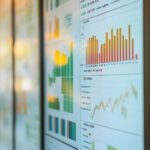Zennemis – As we look ahead, how can we meet the food needs of a growing global population expected to hit 10 billion by 2050? The farming world is changing fast, thanks to big data analytics in agriculture. This shift is moving us from old ways to new tech-powered methods. We aim for sustainable and efficient farming practices.
Projects like the Unmanned Aerial Systems, Plant Sciences, and Education (UASPSE) project, backed by the National Science Foundation, are leading the way. The USDA’s I-FARM initiative is also boosting precision agriculture. These efforts are changing how we manage farm data.
Now, smart farming solutions are key for farmers wanting to use resources wisely and ensure food for everyone. Let’s dive into how these changes are transforming farming.
The Emergence of Data-Driven Agriculture
Data-driven agriculture is changing how we farm today. Before, farming was based on gut feelings and limited info, leading to waste. Now, farmers use precise data to make better choices. This is crucial because the world’s population is expected to hit 10 billion by 2050, making farming more important than ever.
Transition from Traditional Methods
Farmers are leaving old ways behind and adopting new tech. They use systems that collect and analyze data in real-time. This helps them make smart choices instead of guessing. About half of U.S. farms now use farm management software, showing they’re serious about getting better and more efficient.
Enhanced Decision-Making Processes
Big data analytics is a game-changer for farming. It helps farmers manage resources better and assess risks. For example, digital lenders like Bankbarn use farm data for credit checks. This mix of tech and farming not only helps with money matters but also supports green farming.
| Data-Driven Agriculture Benefits | Technology Impact | Statistics |
|---|---|---|
| Increased Efficiency | Precision agriculture technologies | Up to 70% increase in production needed by 2050 |
| Sustainability | Smart irrigation systems | Potential savings of $164 billion globally |
| Crops Yield Improvement | Ag decision support systems | $3 billion saved per year in maintenance costs |
| Cost Reduction | Big data analytics in supply chain management | $1.2 billion saved annually for labor |
Big data analytics has brought new chances to farming. It boosts productivity and supports green farming, making food safer for consumers. As we move forward, using data will be key to shaping agriculture’s future.
Precision Agriculture: Tailoring Farming to the Land
Precision agriculture uses technology to make farming better. It matches farming with the land’s unique needs. With tools like satellite imagery and IoT, we get important data on crops. This lets us make smart choices for each field, changing how we farm.
Utilizing Satellite Imagery and IoT
Satellite images and IoT help us understand soil, crop health, and weather. They let us watch over fields with great accuracy. For example, new satellite images give us detailed info on environmental changes.
Drones with RTK technology make checking fields fast. What took days before can now be done in 30 minutes.
Resource Optimization Techniques
Using resources wisely is key in precision agriculture. With Variable Rate Technology (VRT), we apply water, fertilizers, and pesticides just right. This cuts waste and boosts production.
Managing data helps us see how we use resources. This leads to using less water and fewer chemicals. These new ways help farmers and protect the environment.
Big Data Analytics in Agriculture: Benefits and Applications
Big data analytics has changed how we farm, bringing many benefits. It makes farming more productive and sustainable. By using advanced tech, we can improve how we farm, leading to more crops and a healthier planet.
Increased Crop Yields
Managing farm data helps predict yields and plan better. Farmers can make smart choices about when to plant and harvest. With big data, quick actions can reduce losses from unexpected problems.
Also, it makes getting products to market faster, boosting efficiency.
Environmental Sustainability Integration
Keeping the environment safe is key in farming. Big data helps use energy wisely and promotes sustainable farming. Precision farming uses detailed info to manage resources better.
This helps us make choices that are good for the planet. Watching weather and supply chain data helps create strategies that protect the environment.
Cost Reduction and Risk Mitigation
Using agritech analytics cuts costs by improving how farms work. Predictive maintenance can stop equipment failures before they happen, saving time and money. Data-driven decisions lead to new pricing that matches market needs.
By looking at market trends and past data, farmers can manage their stock better. This reduces risks from market changes.
In short, big data analytics makes farming better by boosting productivity, promoting sustainability, and cutting costs. It helps us innovate and adapt, leading to a more efficient and green future for farming.
Challenges in Implementing Big Data Analytics
Bringing big data analytics into farming faces big challenges. One big issue is the quality and standard of farm data. Different ways of collecting data lead to inconsistent results. It’s crucial to have uniform data practices for trustworthy insights.
This uniformity helps in making better decisions. It also helps solve the problem of integrating data. A strong focus on standardization is key for farmers.
Data Quality and Standardization Issues
Smart farming faces a big challenge with data quality. Data comes in many formats and levels of accuracy. This makes it hard to combine data for useful insights.
Without a clear way to ensure data quality, big data analytics won’t work as well. This means farmers might not see the full benefits.
Resistance to Technology Adoption in Farming
Many farmers are slow to accept new tech, like big data analytics. They might not know how to use digital tools. This makes them hesitant to invest in advanced analytics.
Some farmers don’t see the value in these technologies. Others face financial challenges, especially small-scale farmers. To help, educational programs and training are crucial. Teaching farmers about the benefits of data-driven farming can encourage more to adopt these new methods.
Conclusion
Big data analytics is changing farming with advanced tech like precision agriculture and IoT. It uses real-time data on soil, weather, and crop health. This makes farming more efficient and sustainable, reducing waste.
This shift helps us produce more food for the growing global population. By 2050, we’ll need nearly 10 billion people fed. Big data helps us meet this challenge.
Predictive analytics helps us predict risks like droughts and pests. This lets us make better decisions on planting and choosing crops. Big data also helps us manage our supply chains better, cutting waste and matching production with market needs.
This leads to more crops and lower costs. These are key for the future of farming.
Dealing with data quality and adopting new tech is a challenge. But, we must keep moving forward. Using big data in farming will help us adapt and succeed. By working together, we’re creating a better, sustainable future for farming.
FAQ
What is big data analytics in agriculture?
Big data analytics in agriculture means using advanced data tech to handle lots of farm-related data. It helps farmers make smart choices, improving how they manage crops and work more efficiently.
How does precision agriculture benefit farmers?
Precision agriculture uses tech like satellite images and IoT to get real-time data on farming. This info lets farmers fine-tune their farming, use resources better, and grow more crops.
What role does IoT play in modern agriculture?
IoT is key in modern farming by linking devices and sensors. They collect data on soil, crop health, and weather. This helps farmers make quick, smart decisions to boost productivity.
How can big data improve sustainability in agriculture?
Big data helps make farming more sustainable by improving how resources are used and cutting down on waste. With data insights, farmers can adjust their methods to protect the environment and still produce plenty of food.
What are the main challenges associated with implementing big data analytics in agriculture?
Big challenges include making sure the data is good quality and consistent. Also, some farmers might not want to use new tech because they don’t know how or can’t afford it.
How does agricultural decision support systems enhance farm operations?
These systems make decision-making easier by combining data from different sources like weather and soil conditions. This helps farmers make better farming plans, leading to better crop care and more crops.
What is the significance of agritech analytics for the agricultural industry?
Agritech analytics uses data tech to look at how farming works and performs. It helps farmers work smarter, spend less, and take better care of the environment.
What does data-driven agriculture encompass?
Data-driven agriculture uses analytics to improve farming in every way, from managing crops to predicting yields. It helps farmers make smart choices for better productivity and caring for the land.




